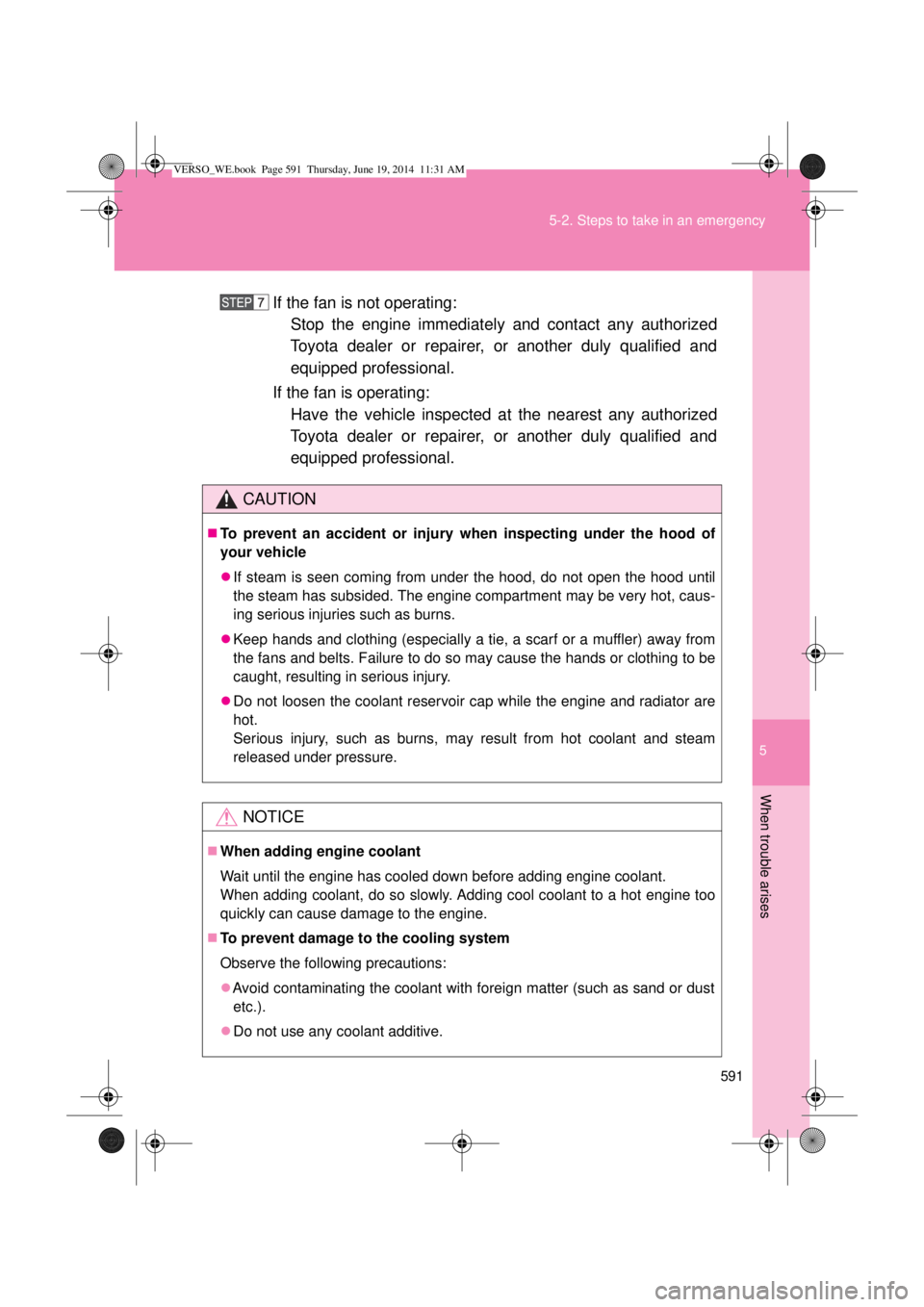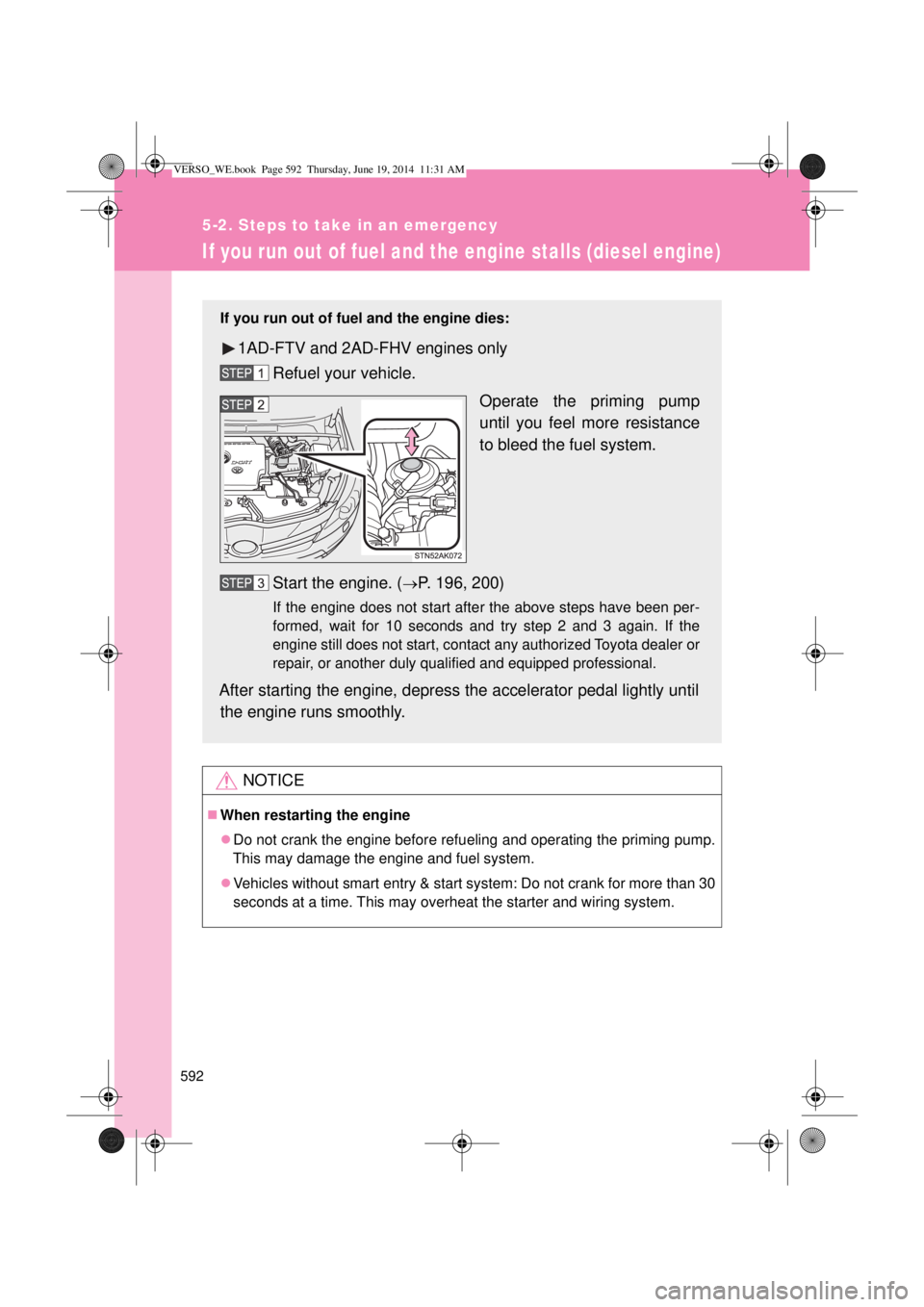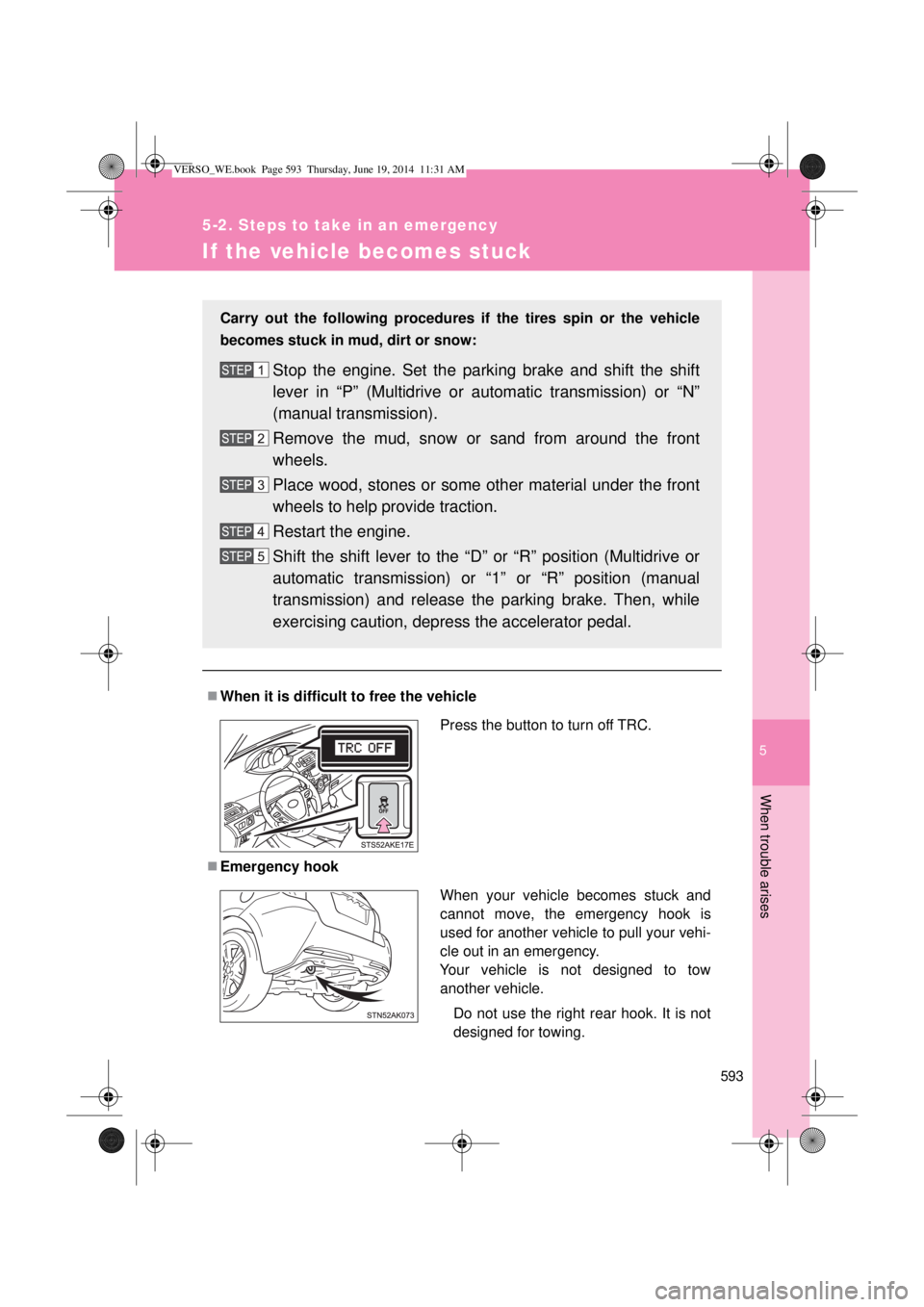Page 591 of 650

5
591 5-2. Steps to take in an emergency
When trouble arises
If the fan is not operating:
Stop the engine immediately and contact any authorized
Toyota dealer or repairer, or another duly qualified and
equipped professional.
If the fan is operating:
Have the vehicle inspected at the nearest any authorized
Toyota dealer or repairer, or another duly qualified and
equipped professional.
CAUTION
To prevent an accident or injury when inspecting under the hood of
your vehicle
If steam is seen coming from under the hood, do not open the hood until
the steam has subsided. The engine compartment may be very hot, caus-
ing serious injuries such as burns.
Keep hands and clothing (especially a tie, a scarf or a muffler) away from
the fans and belts. Failure to do so may cause the hands or clothing to be
caught, resulting in serious injury.
Do not loosen the coolant reservoir cap while the engine and radiator are
hot.
Serious injury, such as burns, may result from hot coolant and steam
released under pressure.
NOTICE
When adding engine coolant
Wait until the engine has cooled down before adding engine coolant.
When adding coolant, do so slowly. Adding cool coolant to a hot engine too
quickly can cause damage to the engine.
To prevent damage to the cooling system
Observe the following precautions:
Avoid contaminating the coolant with foreign matter (such as sand or dust
etc.).
Do not use any coolant additive.
VERSO_WE.book Page 591 Thursday, June 19, 2014 11:31 AM
Page 592 of 650

592
5-2. Steps to take in an emergency
If you run out of fuel and the engine stalls (diesel engine)
NOTICE
When restarting the engine
Do not crank the engine before refueling and operating the priming pump.
This may damage the engine and fuel system.
Vehicles without smart entry & start system: Do not crank for more than 30
seconds at a time. This may overheat the starter and wiring system.
If you run out of fuel and the engine dies:
1AD-FTV and 2AD-FHV engines only
Refuel your vehicle.
Operate the priming pump
until you feel more resistance
to bleed the fuel system.
Start the engine. (
P. 196, 200)
If the engine does not start after the above steps have been per-
formed, wait for 10 seconds and try step 2 and 3 again. If the
engine still does not start, contact any authorized Toyota dealer or
repair, or another duly qualified and equipped professional.
After starting the engine, depress the accelerator pedal lightly until
the engine runs smoothly.
VERSO_WE.book Page 592 Thursday, June 19, 2014 11:31 AM
Page 593 of 650

5
593
5-2. Steps to take in an emergency
When trouble arises
If the vehicle becomes stuck
When it is difficult to free the vehicle
Emergency hook Carry out the following procedures if the tires spin or the vehicle
becomes stuck in mud, dirt or snow:
Stop the engine. Set the parking brake and shift the shift
lever in “P” (Multidrive or automatic transmission) or “N”
(manual transmission).
Remove the mud, snow or sand from around the front
wheels.
Place wood, stones or some other material under the front
wheels to help provide traction.
Restart the engine.
Shift the shift lever to the “D” or “R” position (Multidrive or
automatic transmission) or “1” or “R” position (manual
transmission) and release the parking brake. Then, while
exercising caution, depress the accelerator pedal.
Press the button to turn off TRC.
When your vehicle becomes stuck and
cannot move, the emergency hook is
used for another vehicle to pull your vehi-
cle out in an emergency.
Your vehicle is not designed to tow
another vehicle.
Do not use the right rear hook. It is not
designed for towing.
VERSO_WE.book Page 593 Thursday, June 19, 2014 11:31 AM
Page 595 of 650
5
595
5-2. Steps to take in an emergency
When trouble arises
If your vehicle has to be stopped in an emergency
Only in an emergency, such as if it becomes impossible to stop the
vehicle in the normal way, stop the vehicle using the following pro-
cedure:
Steadily step on the brake pedal with both feet and firmly
depress it.
Do not pump the brake pedal repeatedly as this will increase the
effort required to slow the vehicle.
Shift the shift lever to “N”.
If the shift lever is shifted to “N”
After slowing down, stop the vehicle in a safe place by the
road.
Stop the engine.
If the shift lever cannot be shifted to “N”
Keep depressing the brake pedal with both feet to reduce
vehicle speed as much as possible.
Vehicles without smart entry &
start system: Stop the engine
by turning the engine switch to
the “ACC” position.
VERSO_WE.book Page 595 Thursday, June 19, 2014 11:31 AM
Page 596 of 650
596 5-2. Steps to take in an emergency
CAUTION
If the engine has to be turned off while driving
Power assist for the brakes and steering wheel will be lost, making the
brake pedal harder to depress and the steering wheel heavier to turn.
Decelerate as much as possible before turning off the engine.
Vehicles without smart entry & start system: Never attempt to remove the
key, as doing so will lock the steering wheel.
Vehicles with smart entry &
start system: To stop the
engine, press and hold the
“ENGINE START STOP”
switch for 2 consecutive sec-
onds or more, or press it
briefly 3 times or more in suc-
cession.
Stop the vehicle in a safe place by the road.
Press and hold for 2 seconds or more,
or press briefly 3 times or more
VERSO_WE.book Page 596 Thursday, June 19, 2014 11:31 AM
Page 599 of 650
599 6-1. Specifications
6
Vehicle specifications
Drawbar load
Except 1AD-FTV
engine55 kg (121 lb.)
1AD-FTV engineGross combination vehicle
mass
*9 is 3760 kg
60 kg (132 lb.)
Gross combination vehicle
mass
*9 other than 3760 kg
55 kg (121 lb.)
Towing capacity
With brake
Except 1AD-FTV
engine
1AD-FTV engine1300 kg (2866 lb.)
Gross combination vehicle
mass
*9 is 3760 kg
1500 kg (3307 lb.)
Gross combination vehicle
mass
*9 other than 3760 kg
1300 kg (2866 lb.)
Without brake 450 kg (992 lb.)
Maximum permissible mass for towing
hitch/bracket
*320 kg (44 lb.)
VERSO_WE.book Page 599 Thursday, June 19, 2014 11:31 AM
Page 600 of 650
600 6-1. Specifications
*1: Unladen vehicles
*2: Vehicles with rough road area spec
*3: Vehicle category N1 models
*4: 1ZR-FAE engine
*5: 2ZR-FAE engine
*6: 1AD-FTV engine
*7: 2AD-FHV engine
*8: 1WW-FHV engine
*9: Check the gross combination vehicle mass described on the information tag
(manufacture’s label). (P. 304, 601)
To distinguish the vehicle category, ask any authorized Toyota dealer or
repairer, or another duly qualified and equipped professional.
VERSO_WE.book Page 600 Thursday, June 19, 2014 11:31 AM
Page 602 of 650
602 6-1. Specifications
Engine number
The engine number is stamped on the engine block as shown.
1ZR-FAE and 2ZR-FAE engines
1AD-FTV and 2AD-FHV engines
1WW-FHV engine
VERSO_WE.book Page 602 Thursday, June 19, 2014 11:31 AM